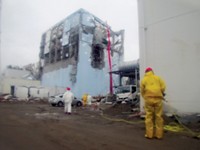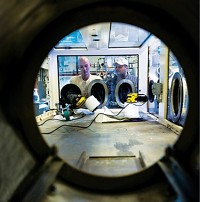Advertisement
Grab your lab coat. Let's get started
Welcome!
Welcome!
Create an account below to get 6 C&EN articles per month, receive newsletters and more - all free.
It seems this is your first time logging in online. Please enter the following information to continue.
As an ACS member you automatically get access to this site. All we need is few more details to create your reading experience.
Not you? Sign in with a different account.
Not you? Sign in with a different account.
ERROR 1
ERROR 1
ERROR 2
ERROR 2
ERROR 2
ERROR 2
ERROR 2
Password and Confirm password must match.
If you have an ACS member number, please enter it here so we can link this account to your membership. (optional)
ERROR 2
ACS values your privacy. By submitting your information, you are gaining access to C&EN and subscribing to our weekly newsletter. We use the information you provide to make your reading experience better, and we will never sell your data to third party members.
Energy
Fukushima Plant Reaching Stability
Nuclear Accident: Progress in containing damage means a cold shutdown could happen early next year
by Glenn Hess
August 1, 2011
| A version of this story appeared in
Volume 89, Issue 31

Tokyo Electric Power Co. (TEPCO) is steadily making progress in its efforts to contain damage and stabilize the crippled Fukushima Daiichi nuclear power plant, the head of the United Nations’ nuclear monitoring agency said last week.
Yukiya Amano, director general of the International Atomic Energy Agency (IAEA), said plant operator TEPCO has made notable headway in dealing with the crisis. On the basis of the progress made to date, he said, the utility’s plan to achieve a safe state by early next year, known as a cold shutdown, is possible.
“IAEA welcomes the significant progress TEPCO has achieved overall in implementing its road map to contain and stabilize the situation,” Amano remarked before visiting the accident site on July 25 for the first time since the nuclear crisis began four months ago.
Workers have been struggling to prevent radioactive contaminants from escaping the six-reactor facility since a massive earthquake and tsunami in March knocked out power and cooling systems at the Fukushima complex, eventually causing a series of explosions and partial core meltdowns.
TEPCO said in mid-July that the first stage of a plan to cool and stably reduce radiation leaks from the damaged reactors had succeeded. The company is also sticking to a previously declared January 2012 timetable for a cold shutdown, which would prevent the evaporation of fluid used to cool reactor materials and prevent the escape of radiation.
Once the plant is in a stable shutdown, the focus will shift to removing radioactive debris and getting spent fuel rods safely out of the damaged reactors. A full decommissioning of the reactors could take more than 10 years, officials have said.
Amano also indicated that IAEA is prepared to assist Japan in dealing with the ongoing crisis. “IAEA can provide knowledge on various areas, including decontamination and extraction of spent nuclear fuel rods,” he said at a news conference after touring the stricken complex. “I would like to discuss specifics with the Japanese government.”




Join the conversation
Contact the reporter
Submit a Letter to the Editor for publication
Engage with us on Twitter